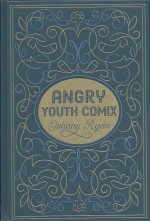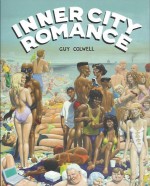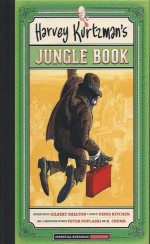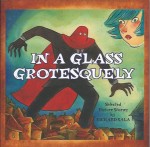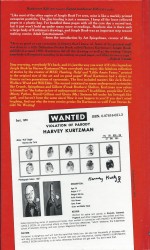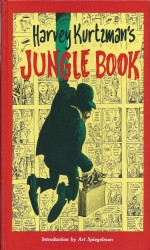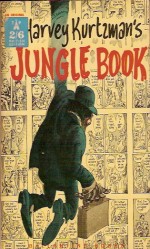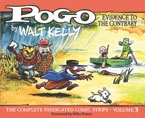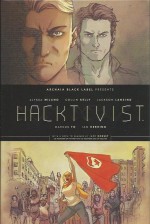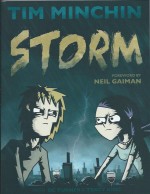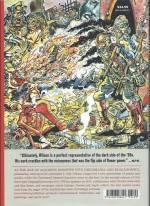
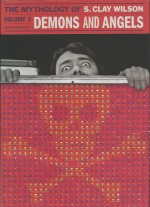
By S. Clay Wilson, edited by Patrick Rosenkranz (Fantagraphics Books)
ISBN: 978-1-60699-844-1
This book is filled with dark, violent sexual imagery and outrageous situations intended to make adults laugh and think. Please be aware that means nudity, images of extreme violence, sexual intimacy, excess of every kind and language commonly used in the privacy of the bedroom, drunken street brawls and – I suspect – school playgrounds whenever supervising adults aren’t present.
If the thought of it all offends you, read no further and don’t buy the book. The rest of us will enjoy some of the most groundbreaking cartoon experiences ever created without you.
Steve Clay Wilson was a pioneering trailblazer within America’s transformative Underground Commix movement: an uncompromising, controversial, in-your-face architect of the counterculture, constantly challenging attitudes and sensitivities whilst telling the kind of cartoon tales he wanted (or perhaps had) to. Something of a contradiction to those who knew him, charming, charismatic Wilson lived life to the full and took his art seriously.
And what art! Stark, complex, shocking, incredibly detailed tableaux jumping with modern Rabelaisian content: mesmerising scenes packed with intense multi-layered busyness, crammed with outrageous, iconic characters in constant surging motion – mostly combative, lewdly licentious and hilariously violent.
The manly hedonistic exuberance of frantic fighters rejoicing in the wild freedom as exemplified by bikers, cowboys, pirates, bull dykes and devils, augmented by other violent ne’er-do-wells, grotesques, human-scaled beasts and things which could be drawn but never described…
His work seethed and abounded with excess: monsters, mutilations, booze- and drug-fuelled romps populated with priapic plunderers and ravening beasts, dangerous and disturbed women and always, always unsettling scenes of society’s biggest taboos – sex and personal freedom.
Americans already worshipped violence; Wilson simply pushed the optics for that sacrament as far as he could, straight into surreal parody. Everybody who knew Wilson adored him, but around him they were usually a little nervous and stepped lightly…
The contemporary successor to Peter Bruegel and Hieronymus Bosch moved on to other artistic arenas when the Underground movement foundered but he never toned down or curbed his visions. In 2008 he suffered massive brain damage in mysterious circumstances and has been undergoing full-time palliative care ever since.
This second intimate, informative oversized (286 x 202 mm) hardback biography/graphic overview is compiled from previous writings and extensive interviews with the people he grew up with and who shared his eventful life.
Moreover each telling anecdote and reminiscence is augmented with photos, paintings, illustrated letters and private or previously unpublished artworks, with each chapter offering a wealth of strips, comprising most of his output from the decline of the counterculture in the mid 1970s to the graphic renaissance of the 1980s.
Before our hagiography of horrors resumes, fellow cartoonist, bosom buddy and contemporary fun-seeker Joe Schenkman paints a torrid word-picture in his Introduction: Where Eagles Soar, after which ‘From Underground to Alternative’ describes the slow painful end of Underground Commix and subsequent downturn in the massive sales its iconoclastic cartoonists enjoyed during the 1960s, whilst relating how the true survivors moved into other areas of expression and more legitimate publishing arenas.
The cultural pendulum swing actually benefited the most dedicated and talented artistic visionaries like R. Crumb, Gilbert Shelton, Spain Rodriguez and Wilson, and this section looks at our wayward rebel’s easy shuffle into commissioned art, gallery-shows, covers and commercial illustration as well as his return to comicbook notoriety in the 1980s after being sought out by Steve Bissette and John Totleben for their horror anthology Taboo. “Wil-sin†more than lived up to his reputation…
Jam-packed with illustrations, this history is rounded off with more astounding strips and his manic, hyper-complex tableaux-spreads (he called them “Deep Scenesâ€) including ‘Angels & Devils’ and ‘Wanda and Tillie featuring Jesus’ from Zap Comix #6, (1973), as well as ‘Rough Trade Lib’, the apocalyptic ‘Futuristic Glimpses’ and convoluted shock-spreads ‘Dyke Pirates Rescue Their Captain from the Diabolic Doctors of Dover’, ‘Maarooouufffaaolloo’ from the following year’s Zap #7, whilst 1975’s 2 (Two), originally housed ‘Brutal Youths Trounce Lawful Citizens for Ticket Money’, ‘Suds Smut’, ‘Un Acte’, ‘The Possessed, Exorcists, Demons and Gurus in a Free-for-All’ and ‘The Captain Died Twice’ before the same productive year’s 2² (Two Squared) delivers the epic examination of social atrocity ‘Lester Gass – the Midnight Xenophobe’…
The next essay concentrates on the legendary artistic collaborations of Wilson, Spain, Robert Crumb, Gilbert Shelton, Victor Moscoso, Robert Williams and Rick Griffin who periodically and competitively reunited through the 1970s and 1980s to release new material in an occasional anthology like no other.
‘Zap Forever!’ offers history and insight supplemented by a wealth of Wilson’s stunning and controversial material beginning with ‘Riot in Cell Block Number Nine’ assorted short tales of ‘The Checkered Demon’, ‘Travelin’ Assassin’ and ‘The Sawbones Sews on the Captain’s Ear Following the Fray’ from Zap Comix #9 (1978), ‘The Swap’ and ‘Star-Eyed Stella’ from #8 in 1975, whilst issue #10 (1982) featured the haunting ‘Bums and the Bird-Spirit’ and ‘Captain Pissgums and his Pervert Pirates Sail Again!’
Also rousing ire and poking gorges are vivid Deep Scenes ‘Vampires with Their Dates and Victims Peruse Count von Sangre’s Basement Exhibition of Satanic Icons’, ‘The Checkered Demon and a Couple of Friends Relax in a Rustic Pub’, ‘Rotting Zombies Take Vengeance Upon the Pirates Who Had Shang-Haid Them’ from Zap Comix #11, (1985) offering the artist’s latest obsession and newest entries to his repertoire of grisly characters: zombies!
Back in educational mode ‘Wilson Abroad’ covers the artist’s life in beloved San Francisco bars and forays into book illustration – most notably covers and interiors for archival German editions of writers like William Burroughs – as well as the maverick’s European tours and booze-soaked trips to England and Scotland, augmented by a plethora of fascinating photos and commercial images.
This section includes a barrage of brilliant comics pieces which begin with the infamous Checkered Demon adventure-strip originally serialised in The Berkeley Barb newspaper from 1976-77 and later collected as The Checkered Demon #1 from Last Gasp.
These sordid sorties are followed by ‘The Checkered Demon Meats the Rotting Zombies Countess!’ (Weird Smut 1985), ‘The Checkered Demon Searches for the Perfect Pint!’, (Knockabout #2, 1981), ‘Captain Rosy Namrooth and her Crew Attempt to Prevent the Checkered Demon from Rescuing Star-Eyed-Stella and her Witch Sister through a Hole in the Hull’ (Boiled Owl #3 1981), ‘Give Me Them Pills’ (Jump Start #1, 1983), ‘A Gluetette and her Rotting Zombie Beau Discover the Little Syringe that Nobody Wanted’ (Jump Start #2, 1987), ‘The Checkered Demon and Deke the Blade Find the Dealer Dead in his Dank Little Room’ (Blatch #13. 1986), ‘Last Call!’ (Heck 1989), ‘Gems and Junk’ (Jump Start #2, 1987) and ‘Psycho Fat Boys’ from Too Fun Too Huge #2 1988.
A peek at the frequently controversial coterie of ‘Wilson’s Characters’ grants access to many unseen private works and unpublished material, neatly segueing into a mostly full-colour selection of works including ‘Babbs Crabb and Her Friend Bernice Meet the Male Chauvinist Peg!’ (Barbarian Women #2, 1977), the cover to Barbarian Women #2, front and back covers for The Checkered Demon #1, II (1978) and III (1979), Britain’s Knockabout #2 cover, The Ugly Head 1981 cover plus The Ugly Head from Yama Yama/The Ugly Head, the cover of Zap Comix #9 and front & back covers for both 2 (Two) and 2² (Two Squared) before this eclectic collection concludes with an invitation to view the artist’s middle years of ‘Domestic Tranquility’.
These social interactions are all accompanied by fascinating, rare illustrations such as fliers for ‘St. Pat’s Bash at Dick’s Bar’ (1984) and ‘Dicknic!’ (1987), plus 17 stunning Private Commissions, the cover to crime novel Blind Pig, and an album cover for ‘More Fun Than an Open Casket Funeral’ by The Accüsed from 1989, before the lesson endeth with a copious listing of Selected Works by S. Clay Wilson…
Erudite, intimately informative yet utterly engaging, this superb collation, contrived and shepherded by the informationally insatiable Patrick Rosenkranz, offers unmissable insights into of one of the most important cartoonists in American history. Just like its precursor, this is a book no serious lover of the art form or devotee of grown-up comics can afford to miss.
The Mythology of S. Clay Wilson Volume Two: Demons and Angels © 2015 Fantagraphics Books. All comics and images by S. Clay Wilson © 2015 S. Clay Wilson. All biographical text © 2015 Patrick Rosenkranz. All other material © 2015 its respective creators and owners. All rights reserved.

